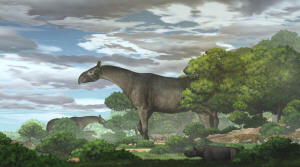|
The
fossils including a skull and two vertebrae found in the
reddish-brown sandstone of the Linxia basin shed light on how
the ancient rhinos, some of the largest land mammals ever,
evolved and moved across what is now Asia.
The dispersal of giant rhino fossils - others have been found on
the far side of the Himalayas in Pakistan - indicate "Tibet, as
a plateau, did not yet exist and was not yet a barrier to
exchange of largest land mammals," the paper said.
Giant rhinos like the newly discovered species, named
Paraceratherium linxiaense, were hornless, long-necked
herbivores, perhaps weighing 20 tonnes - equal to several
elephants - and likely living in open woodland.
(Reporting by Gabriel Crossley; Editing by Tom Hogue)
[© 2021 Thomson Reuters. All rights
reserved.] Copyright 2021 Reuters. All rights reserved. This material may not be published,
broadcast, rewritten or redistributed.
Thompson Reuters is solely responsible for this content.

|
|




